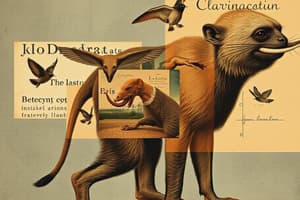Podcast
Questions and Answers
What defines a primate city?
What defines a primate city?
- It has the highest technological advancement.
- It is located at the geographical center of the country.
- It is the country's largest city, at least double the population of the next largest city. (correct)
- It is the smallest city in the country.
What is an example of a primate city?
What is an example of a primate city?
Mexico City
A primate city must have a population less than that of any other city in the country.
A primate city must have a population less than that of any other city in the country.
False (B)
The Rank Size Rule suggests that the largest city should have a population that is half of the __________ city.
The Rank Size Rule suggests that the largest city should have a population that is half of the __________ city.
What is one positive effect of the primate city rule?
What is one positive effect of the primate city rule?
Name one negative effect of primate cities on economic development.
Name one negative effect of primate cities on economic development.
Which of the following is a positive effect of primate cities?
Which of the following is a positive effect of primate cities?
What is meant by the term 'brain drain' in the context of primate cities?
What is meant by the term 'brain drain' in the context of primate cities?
The central place theory is related to the accessibility of __________ in primate cities.
The central place theory is related to the accessibility of __________ in primate cities.
How does a primate city attract international trade?
How does a primate city attract international trade?
Flashcards are hidden until you start studying
Study Notes
Primate Cities
- Largest city in a country is at least double the population of the next largest city, indicating significant influence and dominance.
- Example: Mexico City far exceeds the population of the second-largest city in Mexico.
Primate City Rule
- Defines primate cities; emphasizes the disproportionate size compared to the next city.
Rank Size Rule
- Cities have populations that follow a proportional distribution; typically, the largest city's population is significantly larger than that of the second largest.
Positive Effects of Primate Cities
- Large marketplace facilitates diverse goods and services.
- Economic activity advantages due to concentrated urban environments.
- Access to high-end goods and education supported by a larger threshold population.
- Enhanced flow of information and ideas, promoting innovation.
- Centralized transportation and communication networks streamline connectivity.
- Attract global trade opportunities, boosting foreign investment and economic growth.
Negative Effects on Economic Development
- Investments often concentrate in primate cities, hindering nationwide economic balance.
- Resource and wealth distribution becomes uneven, leading to regional disparities.
- Transportation networks may create unequal access to services across regions.
- Challenges with political cohesion and economic development due to centrifugal forces.
- Brain drain occurs as the most talented individuals migrate to primate cities for opportunities, leaving less fortunate areas struggling.
- Disproportionate impact of disasters in primate cities can threaten national stability.
Centralized Infrastructure
- Primate cities benefit from advanced technology, enhancing transportation and communication capabilities.
- Investment in public transportation can reduce ecological footprints.
- Increased population leads to higher revenue, decreasing dependence on personal vehicles.
Attraction of International Trade
- Larger market area in primate cities attracts foreign businesses and trade, improving local economies.
- Establishing relationships with developed countries can support local development and reduce poverty.
Challenges for Surrounding Cities
- Economically struggling cities outside the primate city suffer from uneven development and resource allocation.
- Limited opportunities in smaller cities lead to economic stagnation, as most resources and services are concentrated in the primate city.
Studying That Suits You
Use AI to generate personalized quizzes and flashcards to suit your learning preferences.




